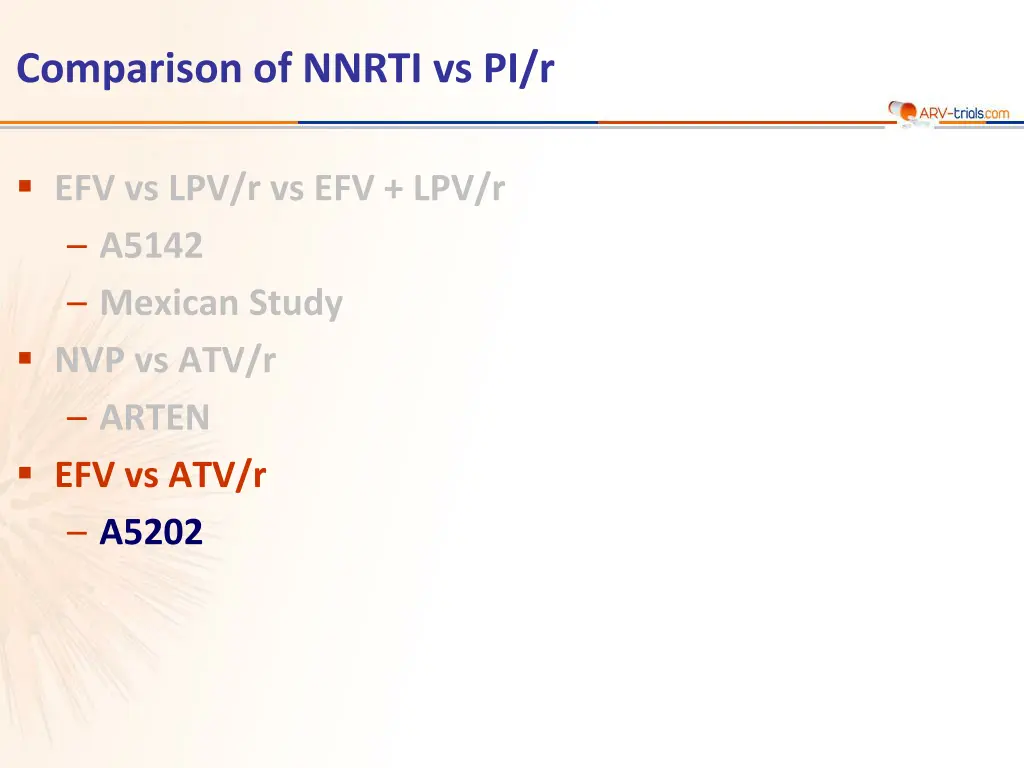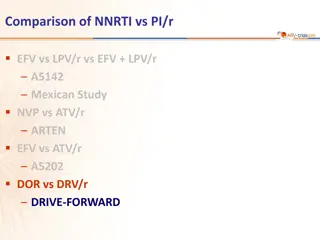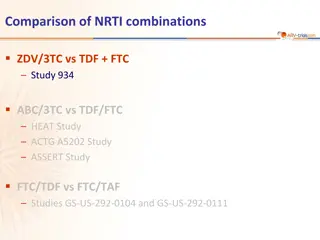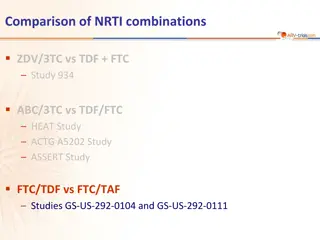
Comparison of NNRTI vs PI/r in HIV Treatment Studies
Explore the comparisons of NNRTI vs PI/r, EFV vs LPV/r, and EFV+LPV/r in HIV treatment studies from A5142 Mexican study, NVP vs ATV/r ARTEN, and EFV vs ATV/r A5202. Discover the results of the ACTG A5202 Study focusing on ABC/3TC vs TDF/FTC in a multicenter, randomized, blinded equivalence study in HIV-1 infected patients, evaluating antiviral activity, safety, and tolerability with EFV or ATV/r.
Download Presentation

Please find below an Image/Link to download the presentation.
The content on the website is provided AS IS for your information and personal use only. It may not be sold, licensed, or shared on other websites without obtaining consent from the author. If you encounter any issues during the download, it is possible that the publisher has removed the file from their server.
You are allowed to download the files provided on this website for personal or commercial use, subject to the condition that they are used lawfully. All files are the property of their respective owners.
The content on the website is provided AS IS for your information and personal use only. It may not be sold, licensed, or shared on other websites without obtaining consent from the author.
E N D
Presentation Transcript
Comparison of NNRTI vs PI/r EFV vs LPV/r vs EFV + LPV/r A5142 Mexican Study NVP vs ATV/r ARTEN EFV vs ATV/r A5202
ACTG A5202 Study: ABC/3TC vs TDF/FTC Multicenter, randomized, blinded equivalence study in 1858 HIV-1 infected patients Comparison of antiviral activity, safety and tolerability of ABC/3TC and TDF/FTC, given with EFV or ATV/r Scheduled interim review by the DSMB of the NIAID: inferior virologic efficacy of ABC/3TC in patients with a screening HIV RNA > 100,000 c/mL Report of data from the 797 patients with screening HIV RNA > 100,000 c/mL Inclusion criteria: HIV-1 infection, > 16 years, < 7 days of prior antiretroviral therapy, acceptable laboratory values Design: randomized, partially blinded study comparing 4 once-daily regimens for the initial treatment of HIV-1 infection: EFV 600 mg or ATV/r 300/100 mg, in combination with ABC/3TC or TDF/FTC (double-blinding for the NRTIs) Randomisation was stratified on screening HIV RNA (> or < 100,000 c/mL) Planned study duration was 96 weeks after enrolment of the last patient Genotypic resistance test was required in patients with recent HIV-1 acquisition Testing for HLA-B*5701 was permitted but not required Sax PE. NEJM 2009;361:2230-40 A5202
ACTG A5202 Study: ABC/3TC vs TDF/FTC Statistical analysis Primary efficacy endpoint: time to virologic failure (confirmed HIV RNA > 1,000 c/mL at or after W16 and before W24, or > 200 c/mL at or after W24) Primary hypotheses: Equivalence of ABC/3TC and TDF/FTC (for each regimens with ATV/r and EFV) Equivalence of ATV/r and EFV (for each NRTI regimen) Equivalence if the two-sided 95% CI for the hazard ratio was between 0.71 and 1.40 (power of 89.8%) Pre specified early-stopping rules for inferiority at annual efficacy review by DSMB Analyses of efficacy by ITT, stratified according to the screening HIV RNA Kaplan-Meier estimation of time-to-event, with comparison by two-sided log-rank tests. Hazard ratios estimated by Cox models Primary safety endpoint: time to the first grade 3 or 4 sign, symptom, or laboratory abnormality at least 1 grade higher than at baseline (except isolated unconjugated bilirubin and creatine kinase) while on randomly assigned treatment Sax PE. NEJM 2009;361:2230-40 A5202
ACTG A5202 Study: ABC/3TC vs TDF/FTC (screening HIV RNA > 100,000 c/mL) Baseline characteristics of the patients with screening HIV RNA > 100,000 c/mL ABC/3TC N = 398 TDF/FTC N = 399 Total N = 797 Median age, years 38 40 39 Female 17% 14% 15% White/Black/Other 43% / 28% / 30% 51% / 24% / 25% 47% / 26% / 27% History of AIDS 26% 22% 24% HIV RNA, log10c/mL, median (IQR) * HIV RNA > 100,000 c/mL HIV RNA 50,000 99,999 c/mL 5.0 (4.7 5.6) 5.0 (4.7 5.6) 5.0 (4.7 5.6) 49% 30% 50% 27% 50% 28% CD4 count/mm3, median (IQR) ** 138 (36 282) 146 (45 294) 145 (41 285) CD4 < 200/mm3 CD4 < 50/mm3 61% 31% 58% 28% 59% 30% HBsAg+ or HCV Ab+ 9% 8% 8% Genotype tested at screening * Geometric mean of screening and entry visits; ** mean of screening and entry visits 44% 42% 43% Sax PE. NEJM 2009;361:2230-40 A5202
ACTG A5202 Study: ABC/3TC vs TDF/FTC (screening HIV RNA > 100,000 c/mL) Time to virologic failure 100 TDF/FTC (26 events) Median follow-up = 60 weeks Discontinuation: 10% = 41 patients on ABC/3TC and 38 on TDF/FTC Risk of subsequent virologic failure among 448 patients with > 2 consecutive HIV RNA < 50 c/mL = 12 in ABC/3TC group vs 9 in TDF/FTC group (p = 0.25) Median CD4/mm3increase at W48: 194 (ABC/3TC) vs 199 (TDF/FTC) 80 Virologic Failure (%) ABC/3TC (57 events) Probability of No 60 p < 0.001, log-rank test Hazard ratio : 2.33 (95% CI : 1.46-3.72) 40 20 0 0 4 16 24 36 48 60 72 84 96 108 Weeks since randomisation No. at risk 398 399 363 313 361 321 267 284 222 236 188 204 137 160 87 104 49 65 20 23 ABC/3TC TDF/FTC Early and late virologic failure according to the protocol-defined criteria by treatment group ABC/3TC N = 57 TDF/FTC N = 26 HIV RNA > 1,000 c/mL at W16 to < W24 without previous level < 200 c/mL 19 9 HIV RNA > 200 c/mL at or after W24 without previous level < 200 c/mL 9 2 HIV RNA > 200 c/mL at or after W24 with previous level < 200 c/mL 29 15 Sax PE. NEJM 2009;361:2230-40 A5202
ACTG A5202 Study: ABC/3TC vs TDF/FTC (screening HIV RNA > 100,000 c/mL) Time to regimen failure* Time to safety endpoint 100 100 TDF/FTC (78 events) TDF/FTC (68 events) Primary Safety Event (%) 80 80 Regimen Failure (%) Probability of No Probability of No 60 60 ABC/3TC (114 events) ABC/3TC (130 events) 40 40 p < 0.001, log-rank test Hazard ratio: 1.87 (95% CI: 1.38-2.54) p < 0.001, log-rank test Hazard ratio: 1.89 (95% CI: 1.43-2.50) 20 20 0 0 0 4 16 24 36 48 60 72 84 96 108 04 16 24 36 48 60 72 84 96 108 Weeks since treatment dispensation Weeks since randomisation No. at risk No. at risk 396 397 341 290 355 316 247 281 206 235 173 204 124 158 78 101 46 63 19 21 397 397 258 219 299 272 177 233 148 188 118 156 82 112 49 71 27 35 5 12 ABC/3TC TDF/FTC ABC/3TC TDF/FTC * Regimen failure: virologic failure or NRTI modification (time to first event) Sax PE. NEJM 2009;361:2230-40 A5202
ACTG A5202 Study: ABC/3TC vs TDF/FTC (screening HIV RNA > 100,000 c/mL) % of patients with HIV-1 RNA < 50 c/mL * 100 TDF/FTC 80 ABC/3TC 60 p = 0.20, chi-square test at week 48 40 20 Weeks since randomisation 0 0 4 16 24 36 48 60 72 84 96 108 No. with RNA value ABC/3TC TDF/FTC 388 393 357 352 324 325 293 285 245 244 212 211 163 169 114 109 59 69 * ITT analysis involving all patients, regardless of prior NRTI discontinuation or virologic failure This analysis represents the aggregate success of both initial (randomly assigned) and subsequent therapy Sax PE. NEJM 2009;361:2230-40 A5202
ACTG A5202 Study: ABC/3TC vs TDF/FTC (screening HIV RNA > 100,000 c/mL) Estimated effect of ABC/3TC (N=398) vs TDF/FTC (N=399) on the hazard of virologic failure Events per 100 person-year Subgroup Hazard Ratio (95% CI) p for interaction Overall 57/398 (14.82) 26/399 (6.34) 2.33 (1.46 3.72) < 0.001 Sex 0.04 Male 50/331 (15.41) 18/345 (5.24) 3.00 (1.74 5.17) Female 7/67 (11.63) 8/54 (11.97) 0.85 (0.30 2.39) Age 0.07 30 yr 3.24 (1.73 6.08) 40 yr 2.08 (1.28 3.39) Race or ethnic group 0.55 White 18/170 (10.33) 8/202 (3.63) 2.82 (1.22 6.53) Black Hispanic 26/112 (26.71) 9/103 (8.87) 12/94 (13.93) 6/93 (6.59) 1.94 (0.96 3.90) 1.35 (0.48 3.83) HIV-1 RNA 0.20 5.5 log10c/mL 6.0 log10c/mL CD4 count 2.64 (1.58 4.40) 3.39 (1.60 7.22) 0.007 50 cells/mm3 3.54 (1.97 6.36) 200 cells/mm3 1.68 (0.98 2.88) Genotype tested at screening Yes 0.02 22/175 (14.05) 3/166 (1.99) 7.21 (2.15 24.2) No 35/223 (15.35) 23/233 (8.88) 1.71 (1.00 2.91) 0.04 1 25 Sax PE. NEJM 2009;361:2230-40 ABC/3TC better TDF/FTC better A5202
ACTG A5202 Study: ABC/3TC vs TDF/FTC (screening HIV RNA > 100,000 c/mL) Grade 3 or 4 signs, symptoms or laboratory abnormalities at least 1 grade higher than the grade at baseline, during the initial regimen ABC/3TC N = 397 130 (33) 41 (10) 15 20 13 7 12 7 3 58 (15) 24 8 9 10 6 8 TDF/FTC N = 397 78 (20) 11 (3) 3 2 4 5 4 7 3 38 (10) 14 8 2 8 10 6 Any lab. abnormality or clinical adverse event, N (%) Metabolic abnormality, N (%) Triglycerides elevation, N Total cholesterol elevation, N LDL-cholesterol elevation, N ALT, N AST, N Diarrhoea or loose stool, N Nausea or vomiting, N General signs or symptoms, N (%) Pain or discomfort, N Rash, N Pruritus, N Fever, N Asthenia, N Headache, N Sax PE. NEJM 2009;361:2230-40 A5202
ACTG A5202 Study: ABC/3TC vs TDF/FTC (screening HIV RNA > 100,000 c/mL) Selected clinical and laboratory events ABC/3TC TDF/FTC p Median change in fasting lipids at W48 (mg/dL) Total cholesterol + 34 + 26 < 0.001 HDL-cholesterol Triglycerides Ratio of total cholesterol to HDL-cholesterol + 9 + 25 - 0,2 + 7 + 3 - 0,2 0.05 0.001 0.5 Suspected study drug-related HSR, N (%) 27 *, ** (7%) 27 ** (7%) Renal failure, N 2 2 Median change in calculated creatinine clearance at W48 (mL/min) + 4 + 2 0.10 Myocardial infarction, N 0 0 Bone fractures, N 7 10 AIDS events, N (%) 26 (7%) 17 (4%) HIV-related cancers, N 8 4 * 1 death after restarting ABC-containing study medication ** subsequent viriologic failure among patients with suspected HSR = 4 in ABC/3TC group, 3 in TDF/FTC group Sax PE. NEJM 2009;361:2230-40 A5202
ACTG A5202 Study: ABC/3TC vs TDF/FTC (screening HIV RNA > 100,000 c/mL) Summary - Conclusion For initial treatment of HIV-1 infection, patients with a screening HIV RNA > 100,000 c/mL whose regimen contains TDF/FTC as compared with ABC/3TC were significantly less likely to experience virologic failure: TDF/FTC superiority in virologic outcome was observed throughout the duration of the study and in multiple sensitivity analyses to experience tolerability failure Possible explanation: ABC/3TC is less potent than TDF/FTC Difference in virologic failure between NRTIs significantly increased with a lower CD4 count Differences in virologic failure persisted after adjustement for multiple baseline covariates Occurrence of suspected hypersensitivity reactions did not influence study outcomes: equal number in both groups, virologic failure infrequent Important implications for clinical practice of this double-blind, randomized, prospective study Patients with high HIV RNA have a risk of virologic failure twice higher with ABC/3TC as compared with TDF/FTC Treatment guidelines recommend to consider results of this study when selecting NRTIs for first-line antiretroviral therapy in patients with high HIV RNA Sax PE. NEJM 2009;361:2230-40 A5202
ACTG A5202 Study: ABC/3TC vs TDF/FTC, in combination with EFV vs ATV/r - Final results (all patients) Patients characteristics at screenning ABC/3TC TDF/FTC Total n = 1,857 EFV n = 465 37 21% 19% 4.7 225 6% 43% ATV/r n = 463 38 16 % 18 % 4.6 236 7% 48% EFV n = 464 39 15% 15% 4.7 234 9% 47% ATV/r n = 465 39 17% 15% 4.7 224 7% 40% Median age, years Female History of AIDS HIV RNA (log10c/ml), median CD4 cell count (/mm3), median HCV Ab+ Genotype at screening 38 17% 17% 4.7 230 7% 45% Results in the 797 patients with screening HIV RNA > 100,000 c/mL : at DSMB action, time to virologic failure was significantly shorter with ABC/3TC as compared with TDF/FTC, independently of 3rddrug [HR (95% CI)]: 2.33 (1.46-3.72) (Sax PE, NEJM 2009;361:2230-40) with EFV: 2.46 (1.20-5.05) with ATV/r: 2.22 (1.19-4.14) A5202 Sax PE, NEJM 2009;361:2230-40) ; Daar ES. CROI 2010; Abs. 59LB
ACTG A5202 Study: ABC/3TC vs TDF/FTC, in combination with EFV vs ATV/r - Final results (all patients) Time to virologic failure Probability of absence of virologic failure at W96 HR (95% CI) Screening HIV RNA < 100,000 c/ml (n = 1,060) ABC/3TC vs TDF/FTC (+ ATV/r) ABC/3TC vs TDF/FTC (+ EFV) 1.26 (0.76-2.05) 1.23 (0.77-1.96) 88.3% vs 90.3% 87.4% vs 89.2% Overall, all patients (n = 1,857) ATV/r vs EFV (+ ABC/3TC) ATV/r vs EFV (+ TDF/FTC) 1.13 (0.82-1.56) 1.01 (0.70-1.46) 83.4% vs 85.3% 89% vs 89.8% In patients with screening HIV RNA < 100,000 c/ml, ABC/3TC and TDF/FTC have similar time to virologic failure, with ATV/r and EFV Overall, ATV/r and EFV have similar time to virologic failure, with both NRTIs Sax PE, NEJM 2009;361:2230-40) ; Daar ES. CROI 2010; Abs. 59LB A5202
ACTG A5202 Study: ABC/3TC vs TDF/FTC, in combination with EFV vs ATV/r - Final results (all patients) Time to tolerability endpoint (modification of originally randomized regimen) Time to primary safety endpoint (Grade 3-4 event) HR (95% CI) p HR (95% CI) p Screening HIV RNA < 100,000 c/ml (n = 1,060) 1.13 1.43 ABC/3TC vs TDF/FTC + ATV/r 0.44 0.018 (0.83 - 1.54) 1.38 (1.03 - 1.85) (1.06 - 1.92) 1.48 (1.12 - 1.95) ABC/3TC vs TDF/FTC + EFV 0.03 0.005 Overall, all patients (n = 1,857) 0.81 0.69 ATV/r vs EFV + ABC/3TC 0.05 0.0008 (0.66 - 1.00) 0.91 (0.72 - 1.15) (0.55 - 0.86) 0.84 (0.66 - 1.07) ATV/r vs EFV + TDF/FTC 0.44 0.17 Daar ES. CROI 2010; Abs. 59LB A5202
ACTG A5202 Study: ABC/3TC vs TDF/FTC: final results (screening HIV RNA < 100,000 c/ml ) In patients with screening HIV RNA < 100,000 c/ml: ABC/3TC compared with TDF/FTC Similar time to virologic failure with ATV/r and EFV Shorter time to safety event with EFV Shorter time to modification with ATV/r and EFV (difference driven by suspected hypersensitivity reactions in ABC/3TC arms) Greater increase in CD4 with EFV Greater increase in total cholesterol, LDL- and HDL-cholesterol with both ATV/r and EFV; greater increase in triglycerides with ATV/r Increase (ABC/3TC) versus modest decline (TDF/FTC) in creatinine clearance with ATV/r Daar ES, CROI 2010, Abs. 59LB Daar ES. CROI 2010; Abs. 59LB A5202
ACTG A5202 Study: ABC/3TC vs TDF/FTC, in combination with EFV vs ATV/r - Final results (all patients) ATV/r compared with EFV (all patients) Similar time to virologic failure with both NRTIs Pre-specified equivalence boundary on HR was not met, as observed W96 event rate was lower than projected (~15% vs 32%) Difference and CIs for probability of being failure free at W96 were within + 10% criteria often used for defining equivalence (post hoc analysis) Longer time to safety event and to 3rddrug modification with ABC/3TC Among virologic failures there was less resistance with both NRTIs Greater increase in CD4 with TDF/FTC Smaller increases in total cholesterol, LDL- and HDL-cholesterol with both NRTIs Modest decline in creatinine clearance with TDF/FTC vs increase with ABC/3TC Daar ES, CROI 2010, Abs. 59LB Daar ES. CROI 2010; Abs. 59LB A5202



